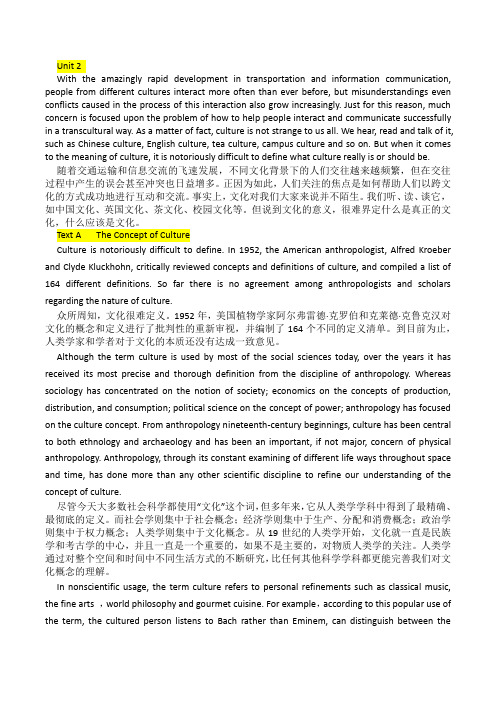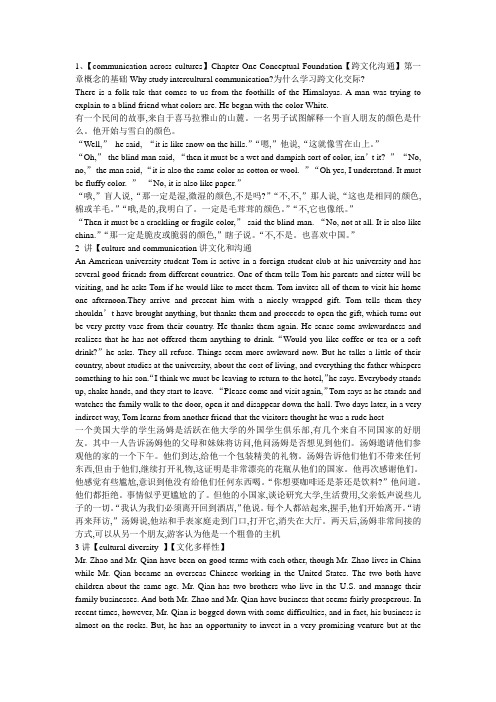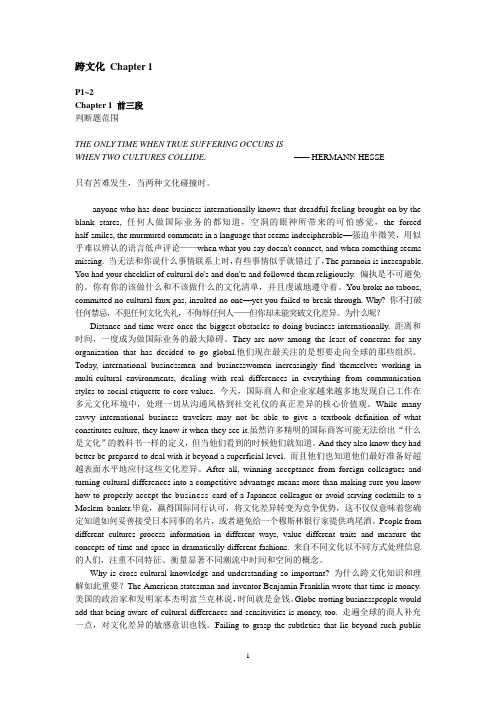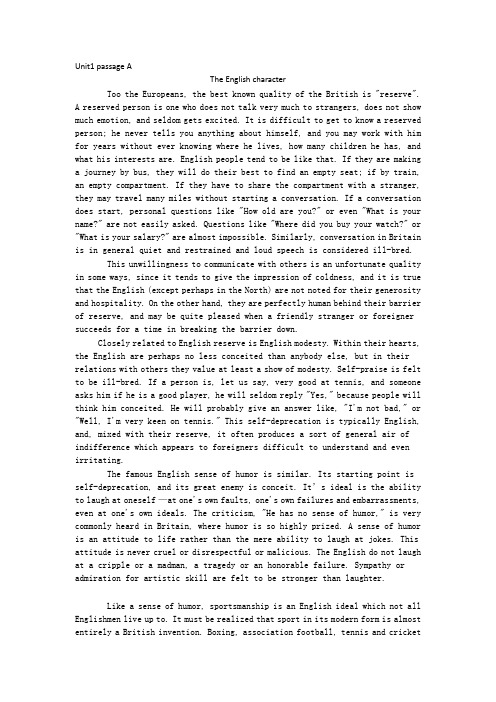跨文化交际翻译
跨文化交际李成明unit2-A原文+翻译PDF

Unit 2With the amazingly rapid development in transportation and information communication, people from different cultures interact more often than ever before, but misunderstandings even conflicts caused in the process of this interaction also grow increasingly. Just for this reason, much concern is focused upon the problem of how to help people interact and communicate successfully in a transcultural way. As a matter of fact, culture is not strange to us all. We hear, read and talk of it, such as Chinese culture, English culture, tea culture, campus culture and so on. But when it comes to the meaning of culture, it is notoriously difficult to define what culture really is or should be.随着交通运输和信息交流的飞速发展,不同文化背景下的人们交往越来越频繁,但在交往过程中产生的误会甚至冲突也日益增多。
正因为如此,人们关注的焦点是如何帮助人们以跨文化的方式成功地进行互动和交流。
事实上,文化对我们大家来说并不陌生。
我们听、读、谈它,如中国文化、英国文化、茶文化、校园文化等。
跨文化交际李成明unit2-A原文+翻译DOCX

Unit 2With the amazingly rapid development in transportation and information communication, people from different cultures interact more often than ever before, but misunderstandings even conflicts caused in the process of this interaction also grow increasingly. Just for this reason, much concern is focused upon the problem of how to help people interact and communicate successfully in a transcultural way. As a matter of fact, culture is not strange to us all. We hear, read and talk of it, such as Chinese culture, English culture, tea culture, campus culture and so on. But when it comes to the meaning of culture, it is notoriously difficult to define what culture really is or should be.随着交通运输和信息交流的飞速发展,不同文化背景下的人们交往越来越频繁,但在交往过程中产生的误会甚至冲突也日益增多。
正因为如此,人们关注的焦点是如何帮助人们以跨文化的方式成功地进行互动和交流。
事实上,文化对我们大家来说并不陌生。
我们听、读、谈它,如中国文化、英国文化、茶文化、校园文化等。
新编跨文化交际【warm up】 原文及翻译

1、【communication across cultures】Chapter One Conceptual Foundation【跨文化沟通】第一章概念的基础Why study intercultural communication?为什么学习跨文化交际?There is a folk tale that comes to us from the foothills of the Himalayas. A man was trying to explain to a blind friend what colors are. He began with the color White.有一个民间的故事,来自于喜马拉雅山的山麓。
一名男子试图解释一个盲人朋友的颜色是什么。
他开始与雪白的颜色。
“Well,”he said, “it is like snow on the hills.”“嗯,”他说,“这就像雪在山上。
”“Oh,”the blind man said, “then it must be a wet and dampish sort of color, isn’t it? ”“No, no,”the man said, “it is also the same color as cotton or wool. ”“Oh yes, I understand. It must be fluffy color. ”“No, it is also like paper.”“哦,”盲人说,“那一定是湿,微湿的颜色,不是吗?”“不,不,”那人说,“这也是相同的颜色,棉或羊毛。
”“哦,是的,我明白了。
一定是毛茸茸的颜色。
”“不,它也像纸。
”“Then it must be a crackling or fragile color,”said the blind man. “No, not at all. It is also like china.”“那一定是脆皮或脆弱的颜色,”瞎子说。
跨文化交际Chapter 1部分翻译

跨文化Chapter 1P1~2Chapter 1 前三段判断题范围THE ONLY TIME WHEN TRUE SUFFERING OCCURS ISWHEN TWO CULTURES COLLIDE. —— HERMANN HESSE只有苦难发生,当两种文化碰撞时。
anyone who has done business internationally knows that dreadful feeling brought on by the blank stares,任何人做国际业务的都知道,空洞的眼神所带来的可怕感觉,the forced half-smiles, the murmured comments in a language that seems indecipherable—强迫半微笑,用似乎难以辨认的语言低声评论——when what you say doesn't connect, and when something seems missing.当无法和你说什么事情联系上时,有些事情似乎就错过了,The paranoia is inescapable. You had your checklist of cultural do's and don'ts and followed them religiously.偏执是不可避免的。
你有你的该做什么和不该做什么的文化清单,并且虔诚地遵守着。
You broke no taboos, committed no cultural faux pas, insulted no one—yet you failed to break through. Why?你不打破任何禁忌,不犯任何文化失礼,不侮辱任何人——但你却未能突破文化差异。
为什么呢?Distance and time were once the biggest obstacles to doing business internationally.距离和时间,一度成为做国际业务的最大障碍。
跨文化交际英语阅读教程课文翻译

跨文化交际英语-阅读教程课文翻译———————————————————————————————————————————————————————————————— 作者作者: : ———————————————————————————————————————————————————————————————— 日期日期: :第一单元现代社会依赖于技术创新现代社会依赖于技术创新,,而技术创新须依靠知识产权来保障。
越来越多的国家遵守国际条约,越来越多的国家遵守国际条约,实行知识产权保护。
实行知识产权保护。
但这方面做得还远远不够。
我们来回顾一下过去,看看缺乏知识产权保护会导致什么样的后果样的后果,,从而吸取教训。
许多西方公司付出了惨痛的代价才发现,知识产权保障机制还未健全时健全时,,在东南亚投资无异于将钱付诸东流。
要进入这些市场,西方公司不仅必须向相关当局说明他们的产品公司不仅必须向相关当局说明他们的产品,,而且还要说明他们产品的制作过程。
而结果经常是本该受到知识产权保护的产品很快被无耻地抄袭。
盗用知识产权的例子不胜枚举。
盗用知识产权的例子不胜枚举。
例如,例如,美国化学制品巨头杜邦向一亚洲国家引进了一种名叫 Londax 的著名除草剂的著名除草剂,,用来除掉稻田里的杂草。
该公司在该产品的研发上投资了数百万美元,该公司在该产品的研发上投资了数百万美元,而且又投入了而且又投入了2500万美元在当地开设了一家生产厂家。
然而,不到一年以后,一瓶瓶非常廉价的冒牌 Lond ax公然上市了。
冒牌产品和正宗产品除了价格外的唯一区别是冒牌产品的名称是Ron dex ,用的是蓝色瓶而不是正宗产品用的绿色瓶。
瓶而不是正宗产品用的绿色瓶。
但是,但是,由于冒牌产品的价格比正宗产品的价格低廉许多,它成功毁掉了杜邦公司的投资。
它成功毁掉了杜邦公司的投资。
同时它也使得该同时它也使得该公司不再愿意投资于新化学制品的研发。
生产Lon dax 的配方本应该被当作是杜邦公司的知识产权。
跨文化交际英语阅读教程课文翻译

跨文化交际英语-阅读教程课文翻译————————————————————————————————作者: ————————————————————————————————日期:第一单元现代社会依赖于技术创新,而技术创新须依靠知识产权来保障。
越来越多的国家遵守国际条约,实行知识产权保护。
但这方面做得还远远不够。
我们来回顾一下过去,看看缺乏知识产权保护会导致什么样的后果,从而吸取教训。
许多西方公司付出了惨痛的代价才发现,知识产权保障机制还未健全时,在东南亚投资无异于将钱付诸东流。
要进入这些市场,西方公司不仅必须向相关当局说明他们的产品,而且还要说明他们产品的制作过程。
而结果经常是本该受到知识产权保护的产品很快被无耻地抄袭。
盗用知识产权的例子不胜枚举。
例如,美国化学制品巨头杜邦向一亚洲国家引进了一种名叫Londax的著名除草剂,用来除掉稻田里的杂草。
该公司在该产品的研发上投资了数百万美元,而且又投入了2500万美元在当地开设了一家生产厂家。
然而,不到一年以后,一瓶瓶非常廉价的冒牌Londax公然上市了。
冒牌产品和正宗产品除了价格外的唯一区别是冒牌产品的名称是Rondex,用的是蓝色瓶而不是正宗产品用的绿色瓶。
但是,由于冒牌产品的价格比正宗产品的价格低廉许多,它成功毁掉了杜邦公司的投资。
同时它也使得该公司不再愿意投资于新化学制品的研发。
生产Londax的配方本应该被当作是杜邦公司的知识产权。
其他非法使用该配方的公司是犯了偷盗行为,就像盗取了杜邦公司的机器或者该公司的其他财产一样。
不光是产品,在亚洲市场上保护一个品牌也曾经是几乎不可能的事。
就连Kellogg’s玉米片的生产商Kellogg’s公司也发现自己的产品被山寨:Kongal 牌玉米条,连包装也几乎一模一样。
不幸的是,和杜邦公司的事件一样,Kellogg’s公司成功惩罚侵权者的几率几乎为零,因为当地的法律不承认知识产权保护的概念。
幸好,在经过许多轮世贸组织的谈判后,情况大为改观。
跨文化交际概念

跨文化交际概念“跨文化交际”的英语名称是“cross-cultural communication(或inter-cultural communication)”。
它指本族语者与非本族语者之间的交际,也指任何在语言和文化背景方面有差异的人们之间的交际。
通俗来说就是如果你和外国人打交道(由于存在语言和文化背景的差异),应该注意什么问题,应该如何得体地去交流。
从对外汉语专业的角度,“跨文化交际”的概念可以这样界定:在特定的交际情景中,具有不同的文化背景的交际者使用同一种语言(母语或目的语)进行的口语交际。
它包含以下几个要点:1.交际双方必须来自不同的文化背景文化背景的差异是一个宽泛的概念,既是指不同文化圈之间的差异,也是指同一文化圈内部亚文化之间的差异。
不过立足对外汉语专业,文化差异主要指不同文化圈之间的差异,尤其是中国和欧美国家的文化差异。
因为从跨文化交际的实际情形来看,由于文化背景的差异导致交际失误,容易引起冲突的主要是中国和欧美国家的人际交往。
中国同亚洲地区国家,如日本、韩国以及东南亚一些国家的人际交往,虽然也有文化差异的一面,但要顺利的多,这是因为这些国家与中国同属东方文化圈,彼此之间在文化取向和交际规范方面有很多相通的地方。
[1]2.交际双方必须使用同一种语言交际这是显而易见的,假如一方使用一种语言,而另一方使用另外一种不同的语言,交际是无法进行的。
但是,既然交际的双方来自不同的文化背景,又要使用同一种语言,那么用来交际的语言对一方来说是母语,而对另一方来说必然是第二语言(习得的“目的语”)。
比如一个中国人与一个美国人交谈,他们可以选择使用汉语,也可以选择使用英语,这样他们就可以用同一种语言直接交际,而不需要通过翻译这个中间环节。
这样界定的着眼点也是由对外汉语专业的特点决定的。
3.交际双方进行的是实时的口语交际跨文化交际的途径多种多样。
可以是语言符号的交际,也可以是非语言符号的交际,如商品、画报、实物、影像、演出到其他物化形式符号的交际;可以是现场的双向交际,也可以是通过媒介的单向交际,如电视、广播、报刊、广告等传播方式的交际;可以是口语交际,也可以是书面交际,如信函、公文等的来往。
大学英语跨文化交际教程翻译 杨晓萍 陶岳炼 主编

Unit1 passage AThe English characterToo the Europeans, the best known quality of the British is "reserve".A reserved person is one who does not talk very much to strangers, does not show much emotion, and seldom gets excited. It is difficult to get to know a reserved person; he never tells you anything about himself, and you may work with him for years without ever knowing where he lives, how many children he has, and what his interests are. English people tend to be like that. If they are making a journey by bus, they will do their best to find an empty seat; if by train, an empty compartment. If they have to share the compartment with a stranger, they may travel many miles without starting a conversation. If a conversation does start, personal questions like "How old are you?" or even "What is your name?" are not easily asked. Questions like "Where did you buy your watch?" or "What is your salary?" are almost impossible. Similarly, conversation in Britain is in general quiet and restrained and loud speech is considered ill-bred.This unwillingness to communicate with others is an unfortunate quality in some ways, since it tends to give the impression of coldness, and it is true that the English (except perhaps in the North) are not noted for their generosity and hospitality. On the other hand, they are perfectly human behind their barrier of reserve, and may be quite pleased when a friendly stranger or foreigner succeeds for a time in breaking the barrier down.Closely related to English reserve is English modesty. Within their hearts, the English are perhaps no less conceited than anybody else, but in their relations with others they value at least a show of modesty. Self-praise is felt to be ill-bred. If a person is, let us say, very good at tennis, and someone asks him if he is a good player, he will seldom reply "Yes," because people will think him conceited. He will probably give an answer like, "I'm not bad," or "Well, I'm very keen on tennis." This self-deprecation is typically English, and, mixed with their reserve, it often produces a sort of general air of indifference which appears to foreigners difficult to understand and even irritating.The famous English sense of humor is similar. Its starting point is self-deprecation, and its great enemy is conceit. It’s ideal is the ability to laugh at oneself —at one's own faults, one's own failures and embarrassments, even at one's own ideals. The criticism, "He has no sense of humor," is very commonly heard in Britain, where humor is so highly prized. A sense of humor is an attitude to life rather than the mere ability to laugh at jokes. This attitude is never cruel or disrespectful or malicious. The English do not laugh at a cripple or a madman, a tragedy or an honorable failure. Sympathy or admiration for artistic skill are felt to be stronger than laughter.Like a sense of humor, sportsmanship is an English ideal which not all Englishmen live up to. It must be realized that sport in its modern form is almost entirely a British invention. Boxing, association football, tennis and cricketwere all first organized and given rules in Britain. Rules are the essence of sport, and sportsmanship is the ability to practise a sport in obedience to its rules, while also showing generosity to one's opponent and good temper in defeat. Moreover, sportsmanship as an ideal is applied to life in general. One of the most elementary rules of life is "never hit a man when he's down"─in other words, never take advantage of another person's misfortune. English school-boys often show this sense of sportsmanship to a surprisingly high degree in their relations with each other.译文:对于其他欧洲人来说,英国人最著名的特点是“谨慎”。
跨文化交际课文翻译

关于跨文化交流,跨文化市场才是第一的真正的首要的范本。
考虑到古罗马帝国的市民,他们是第一个诞生商店的地球文明。
商人们通过在商店的上面树立旗帜来展示他们商品货物的图片来解决跨文化市场的困扰。
这种做法不仅能为罗马帝国中未受过教育的市民服务还能帮助罗马商人们获得被他们用武力征服的殖民地的商业信息。
回顾过去,我们会发现两千多年前的亚里士多德曾明确说过:“有效劝服基本的信念仍可以把他应用到今天的买卖商品上然而在古代的雅典可能会引起一场大的争论”。
很明显的可以看出,交流是现代市场的根基。
毋庸置疑,全球化市场的时代已经到来。
每年超过4万件的商品货物进入国际市场,其中超过一半是来自美国。
这里面85%的商品都不合格。
通往国际化市场成功的道路是建立在失败的市场垃圾碎片和广泛的广告活动之上的。
他们中的大多数之所以会失败,是因为跨文化交流被曲解了。
在跨文化市场里,如果你想把低劣的语言举止降低到最小,那么就不假定任何事情。
几乎我们都听说过关于美国通用汽车公司,他们尽力想把他们的雪佛兰牌汽车销往拉美国家。
但是雪佛兰在说西班牙语的拉美国家按字面意思是不能行走。
当公司发现汽车买不出去的原因时,他们就把车重新命名,然后销往这些国家。
福特汽车公司,美国又一个汽车界的领头羊,也有类似的问题。
他们的pinto 牌汽车在当地也没有达到预期的销售,原因时他们的汽车其意思在当地为男性生殖器。
最终福特公司把所有的名牌汽车重新命名为corcel,其意思为骏马。
伊莱克斯,一个日用电器制造者,其在英国获得了很大的成功。
不幸的是,他们的广告招牌的意思在美国和英国大不相同。
在美国,suck的意思是多虱子的。
英国的牙膏生产商在法国制造出来了一种牙膏叫cue。
它被人们所耻笑。
因为它的名字使人想起了臭名昭著的色情杂志——Cue。
但是市场中的文化意识更多于细心的翻译。
每一文化都有其微妙之处,当然也有其鲜明的禁忌。
尽管大多数的人不能列出他们自己文化的规则,但是他们很明白什么时候这些禁忌被触碰了。
大学英语跨文化交际U5课文翻译、词汇、习语整理

Unit 5Nonverbal communication课前谚语+名言:1、I’s not what he said, but the way he said it.——English saying2、There is a language in her eyes, her cheeks, her lips.——William Shakespeare案例一:个人空间马克最近从丹麦搬到了悉尼,在一家澳大利亚公司当销售员。
他被邀请加入当地的一个俱乐部。
有一天在一个晚会上,一个女成员走近他,马克立即通过谈论展现出了他的兴趣。
起初聊天进行的很顺利,但随着谈话的进行,马克逐渐的向她靠近,而那位女士似乎离他越来越远,并显得很不自在。
当马克正要问她有关于澳大利亚习俗的问题时,站在旁边的一个男士往这边瞟了一眼,她找了个借口离开,去和那个男人说话。
留下马克傻傻的站在那里,他不知道为什么他们的交谈如此突然地停止了。
Question:Why did that women suddenly stop talking with mark and turned to another man?注释:这是一个对身体距离理解不同造成的误会。
在丹麦,正式场合中,个人空间大概在20厘米-30厘米之间。
而在澳大利亚,这样的场合需要40厘米-50厘米的身体距离。
所以丹麦人习惯近距离交谈,澳大利亚人习惯远距离交谈。
在这个情况下,马克尝试去建立自己正常的个人亲密空间,侵犯了澳大利亚女士的空间,正因如此,她感到了某种威胁,失去了舒适感。
就在那时,身旁的男人给了她一个离开的机会。
如果马克对于澳大利亚人所期待的个人空间有所了解的话,或许这个谈话会有所不同。
案例二:使用当地语言的问题。
弗兰克为了做研究的目的从澳大利亚来到中国,为此,他在大学里刻苦学习中文,并且能用中文很方便的和人交流。
而当他到达北京以后,他开始和当地人交谈,询问方向和建议。
尽管他几乎都是用中文和他们交流,但是他发现周围的人有时候会笑着用英语回答他,尽管他们对英语知之甚少。
新编跨文化交际英语教程1~7单元翻译

Unit 2 Page 60 Unit 3 Page 96Unit 5 Page 175 Unit 6 Page 215Case 2A common cultural misunderstanding in classes involves conflicts between what is said to be direct communication style and indirect communication style. In American culture, people tend to say what is on their minds and to mean what they say. Therefore, students in class are expected to ask questions when they need clarification. Mexican culture shares this preference of style with American culture in some situations, and that‘s why the students from Mexico readily adopted the techniques of asking questions in class. However, Korean people generally prefer indirect communication style, and therefore they tend to not say what is on their minds and to rely more on implications and inference, so as to be polite and respectful and avoid losing face through any improper verbal behavior. As is mentioned in the case, to many Koreans, numerous questions would show a disrespect for the teacher, and would also reflect that the student has not studied hard enough.Case 3The conflict here is a difference in cultural values and beliefs. In the beginning, Mary didn’t realize that her Dominican sister saw her as a member of the family, literally. In the Dominican view, family possessions are shared by everyone of the family. Luz was acting as most Dominican sisters would do in borrowing without asking every time. Once Mary understood that there was a different way of looking at this, she would become more accepting. However, she might still experience the same frustration when this happened again. She had to find ways to cope with her own emotional cultural reaction as well as her practical problem (the batteries running out).Case 6When a speaker says something to a hearer, there are at least three kinds ofmeanings involved: utterance meaning, speaker’s meaning and hearer’s meaning. In the dialogue, when Litz said ‘How long is she going to stay?’ she meant to say that if she knew how long her mother-in-law was going to stay in Finland, she would be able to make proper arrangements for her, such as taking her out to do some sightseeing. However, her mother-in-law overheard the conversation, and took Litz’s question to mean “Litz does not want me to stay for long”. From the Chinese point of view, it seems to be inappropriate for Litz to ask such a question just two days after her mother-in-law’s arrival. If she feels she has to ask the question, it would be better to ask some time later and she should not let her mother-in-law hear it.Case 7Keiko insists on giving valuable gifts to her college friends, because in countries like Japan, exchanging gifts is a strongly rooted social tradition. Should you receive a gift, and don’t have one to offer in return, you will probably create a crisis. If not as serious as a crisis, one who doesn’t offer a gift in return may be considered rude or impolite. Therefore, in Japan, gifts are a symbolic way to show appreciation, respect, gratitude and further relationship.Keiko obviously has taken those used items from Mary, Ed and Marion as gifts, for she probably doesn’t know that Americans frequently donate their used household items to church or to the community. Mary, Ed and Marion would never consider those used household items given to Keiko as gifts. No wonder they felt very uncomfortable when they received valuable gifts in return.Case 10In Japan, a company is often very much like a big family, in which the manger(s) will take good care of the employees and the employees are expected to devote themselves to the development of the company and, if it is necessary, to sacrifice their own individual interests for the interests of the company, from which, in the long run, the employees will benefit greatly. But for the French, a company is just a loosely- knit social organization wherein individuals are supposed to take care of themselves and their families. Moreover, the way the French make decisions in the family might also be different from the typical Japanese one, which may not often involve females and the power to decide usually lies with the dominating male. As there are such cultural differences between the Japanese and the French, Mr. Legrand’s decision made Mr. Tanaka feel dumbfounded.Case 12In this case, it seems that the Chinese expectations were not fulfilled. First, having two people sharing host responsibilities could be somewhat confusing to the hierarchically minded Chinese. Second, because age is often viewed as an indication of seniority, the Chinese might have considered the youth of their Canadian hosts as slight to their own status. Third, in China, it is traditional for the host to offer a welcome toast at the beginning of the meal, which is the reciprocated by the guests; by not doing so, the Canadian might be thought rude. The abrupt departure of the Chinese following the banquet was probably an indication that they were not pleased with the way they were treated. The Canadians’ lack of understanding of the Chinese culture and the Chinese ways of communication clearly cost them in their business dealings with the visiting delegation.Case 17When these two men separate, they may leave each other with very different impressions.Mr Richardson is very pleased to have made the acquaintance of Mr Chu and feels they have gotten off to a very good start. They have established their relationship on a first-name basis and Mr Chu’s smile seemed to indicate that he will be friendly and easy to do business with. Mr Richardson is particularly pleased that he had treated Mr Chu with respect for his Chinese background by calling him Hon-fai rather than using the western name, David, which seemed to him an unnecessary imposition of western culture.In contrast, Mr Chu feels quite uncomfortable with Mr Richardson. He feels it will be difficult to work with him, and that Mr Richardson might be rather insensitive to cultural differences. He is particularly bothered that, instead of calling him David or Mr Chu, Mr Richardson used his given name, Hon-fai, the name rarely used by anyone, in fact. It was this embarrassment which caused him to smile. He would feel more comfortable if they called each other Mr Chu and Mr Richardson. Nevertheless, when he was away at school in North America he learned that Americans feel uncomfortable calling people Mr for any extended period of time. His solution was to adopt a western name. He chose David for use in such situations.Case 19Talking about what’s wrong is not easy for people in any culture, but people in high-context countries like China put high priority on keeping harmony, preventing anyone from losing face, and nurturing the relationship. It seems that Ron Kelly had to learn a different way of sending message when he was in China. At home in Canada he would have gone directly to the point. But in China, going directly to the problem with someone may suggest that he or she has failed to live up to his or her responsibility and the honor of his or her organization is in question. In high-context cultures like China, such a message is serious and damaging. In low-context cultures, however, the tendency is just to “spit it out”, to get it into words and worry about the result later. Senders of unwelcome messages use objective facts, assuming, as with persuasion, that facts are neutral, instrumental, and impersonal. Indirectness is often the way members of high-context cultures choose to communicate about a problem. Case 21Sometimes our best intentions can lead to breakdowns (故障)in cross-cultural communication. For example, one of the very common manners of touching --- handshaking --- may result in conflict when performed with no consideration of cultural differences. Among middle-class North American men, it is customary to shake hands as a gesture of friendship. When wanting to communicate extra friendliness, a male in the United States may, while shaking hands, grasp with his left hand his friend’s right arm. However, to people of Middle Eastern countries, the left hand is profane (亵渎的) and touching someone with it is highly offensive. Therefore, in Vernon’s eyes, Kenneth was actually an extremely offensive message to him. Case 22In Puerto Rican culture, as in some other Latin American and Eastern cultures, it is not right for a child to keep an eye-contact with an adult who is accusing him or her, while in the United States, failing of meeting other person’s eye accusing him or her would be taken as a sign of guiltiness. As the principal knew little about this cultural difference in using eye-contact, he decided that the girl must be guilty. Generallyspeaking, avoiding eye-contact with the other(s) is often considered as an insult in some cultures, but may signify respect for authority and obedience in other cultures. Case 25For people from the American culture and western European cultures, one’s time should be scheduled into segments or compartments which are to be kept discrete from one another. They prefer to do one thing at a time. They will be annoyed when they have made an appointment with somebody, only to find a lot of other things going on at the same time. They don’t like to interrupt others and be interrupted by other while they are doing something. In contrast, people from many other cultures including the Chinese culture are more likely to operate with several people, ideas, or matters simultaneously. They are more easily distracted and subject to interruptions, which they would not usually mind very much. The miscommunication between Katherine and the director can be ascribed to their lack of knowledge about each other’s way of using time.In this case, to the Chinese director as well as many other Chinese people, it is natural to handle the other things which needed to be dealt with immediately. He may have thought that, in this way, he utilized the time best. But to Katherine and most Westerners, it’s quite different. They tend to do things strictly according to their schedule and appointments with others, which is their concept of using time best.高语境交流和低语境交流(由高到低排列)Japanese, Chinese, Korean, African American, Native American, Arab, Greek, Latin,Italian,English,Frech,Amercian,Scandinavian,German,German-Swiss。
跨文化交际英语阅读教程Unit 02课后翻译

Checking Is Believing参考译文:验证为实网络随时在拓展,它几乎可以给大多数学科提供无限量的信息。
除了提供大量信息之外,网络使用起来也方便快捷。
如今,我们拥有很多设备它们可以联网并展示信息,即使当你在赶路时也是如此。
因此,网络可以提供一个获取信息的方便途径,而且网络已经受到了学生们的极力推崇。
如果一位学生有条件上网,那么他/她就没有必要去图书馆查找资料。
这样不仅节省了大量的时间也省去了交通费。
几乎可以这样说,学生们比上班族有更多的时间浏览网页,网络上提供的信息有助于他们完成学习任务,这一点成了他们上网的额外动机。
Reading BThis freedom is, of course, in sharp contrast to traditional media. Publishing companies, for example, can be very selective about their authors. Such companies have high standards and will only publish a book if the author is well qualified and experienced in the subject area. Publishers get other experts to review a book before it is printed and further improvements to the book are made by editors and book designers employed by the publishing companies. Editors frequently make suggestions to make the book longer or shorter and to improve the author’s use of language to make the writing clearer and more easilycomprehensible to readers. Designers handle the layout of a book, including the cover, photographs and other graphics and even the font type and style of the text.参考译文:网络提供的这种自由和传统的媒介相比当然有着明显的区别。
跨文化交际_Unit_2_参考翻译

Unit Two Task 11)A smooth sea never made a skillful mariner. 平静的大海决不能造就出熟练的水手。
/花盆里生长不出参天大树。
/温室里长不出栋梁之才。
2)He who would search for pearls must dive below.不入虎穴,焉得虎子。
/ 欲寻珍珠就要潜到水里。
/ 欲寻珍珠欲潜入水。
3)Living without an aim is like sailing without a compass. 生活没有目标如同航行没有罗盘。
/没有目标的生活如同没有罗盘的航行。
4)To have another fish to fry另有要事/ 另有事情得做5)The water that bears the boat is the same that swallows it up.水能载舟,亦能覆舟。
(The same knife cuts bread and fingers.)6)前人栽树,后人乘凉。
One sows and another reaps. / One man sows and another reaps. / One generation plants the trees in whose shade another generation rests. / The precedence planted, the later generations enjoy its cool.7)斩草不除根,逢春又发青。
If the grass is only cut, then the next spring it will revive. / Cut weeds and dig up the roots.8)种田不用问,深耕多上粪。
Planting has no better measures but ploughing deeply and fertilizing much more.9)生米煮成熟饭。
跨文化交际课文翻译

Speaki ng Englis h with a Japane se mind 日本人在达到上学年龄后就要学英语,这些人在学会英语之后就可能用英语进行对外交流,但是他们所使用的英语要受到他们本民族的语言和文化的影响。
因此这就会造成困扰和误解在与其他用英语的人交流时。
AM,当他作为索尼公司的首席执行官时,在一次给美国的商学会做报告时他指出了这两种语言的明显差异。
他举了一个例子,一个美国商人向他的一个日本生意上的伙伴提议了一项计划。
可是当美国人完成时,日本人才开始谈论这个项目听起来多么有趣并且他们公司也有同样的想法。
美国人认为这个项目肯定会被接受。
但是随着辩论的拖延,美国人的关注也开始减弱,然后日本人说,不管怎样。
AM告诫说,接下来就是你要仔细听的时候了。
因为真正的回答是在那个词语的后面。
他经常告诫他的部下官员要用一种大多数的使用英语的人都习惯的方式说话,如果他想被别人理解。
他还告诫说,在日本你可能是大多数,但是到了国外你就是一小部分。
要想用一种大多数人都能最大限度的理解你的方式说话需要更多的语法知识和大量的词汇。
你必须对你所谈话的那个人的交流方式,社交礼仪,价值观等等很熟悉。
日本人的说话顺序正好和说英语的人相反。
甚至就是一个非常简单的句子,比如英国人会说,你得带伞因为要下雨。
而日本人会说,因为会下雨所以你要带伞。
不管这种正常的表达方式的顺序是否会控制想法顺序还是什么,日本人这种用不同顺序的表达信息的方式会让那些说英语的国家的人且对日本语言不了解的人感到困惑。
另一个例子就是,一些说英语的日本人和美国的一些领导举行卫星电视会议来讨论两国间的经济和贸易关系。
日本的参会者说着流利的英语,同时会被翻译成日语以供那些不懂得英语的人理解。
跨文化交际课后翻译原文1--8单元

Translation1The growth of intercultural communication as a field of study is based on a view of history that clearly demonstrates people and cultures have been troubled by a persistent inability to understand and get along with groups and societies removed by space, ideology, appearance, and behavior from their own. What is intriguing about many of human civilization’s failure is that they appear to be personal as well as global. The story of humankind is punctuated with instances of face-to-face conflicts as well as international misunderstanding--major and minor quarrels that range from simple name-calling to isolationism tr even armed conflict. It is obvious that increases contact with other cultures and subcultures make it imperative for us to make a concerted effort to understand and get along with people whose beliefs and backgrounds may be vastly different from our own. The ability, through increased awareness and understanding, to peacefully coexist with people who do not necessarily share our lifestyles or values could benefit us not only in our own neighborhoods but could be the decisive factor in maintaining would peace. Translation 2Culture is something referred to as our mental programming, our “software of the mind.”But we can take that computer analogy further and say that culture is the operating environment that enables software programs to run. Culture is like DOS or Unix or Windows:it is what enables us to process information in various specific applications. The metaphor of windows seems to be very appealing to describe culture:culture is a mental set of windows through which all of life is viewed. It varies from individual to individual within a society, but it shares important characteristics with members of a society. Culture is like the water fish swim in--a reality that is taken for granted and rarely examined. It is in the air we breathe and is as necessary to our understanding of who we are as air is to our physical life. Culture is the property of a community people, not simply a characteristic of individuals. Societies are programmed by culture, and that programming comes from similar life experiences and similar interpretations of what those experiences mean. If culture is mental programming, it is also a mental map of reality. It tells us from early childhood what matters, what o prefer, what to avoid, and what to do. Culture also tells us what ought to be . It gives us assumptions about the ideal beyond what individuals may experience. It helps us in setting priorities. It establishes codes for behavior and provides justification and legitimization for that behavior.Translation 3Although each of us has a unique set of values, there also are values that tend to permeate a culture. These are called cultural values. Cultural values generally are normative in that they inform a member of a culture what is good and bad, right and false, positive and negative, and the like. Cultural values define what is worthwhile to die for, what is worth protecting, what frightens people and their social systems, what are considered proper subjects for study and for ridicule, and what types of events lead individuals to group solidarity. Cultural values also specify what behaviors are of importance and which should be avoided within a culture. Values represent a learned organization of rules for making choices and for resolving conflicts. The values held by participants in intercultural communication are important because values develop standards and guidelines that establish appropriate and inappropriate behaviors in a society. V alues, in other words, help determine how people ought to behave with the result that people will exhibit and expect behaviors according to their value systems. To the extent that cultural value systems differ, we may expect that intercultural communication participants will tend to exhibit and to expect different under similar circumstance.Translation 4When we say that language is always ambiguous, what we mean is that we can never fully control the meaning of the things we say and write. The meanings we exchange by speaking and by writing are not given in the words and sentences alone but are also constructed partly out of what our listeners and our readers interpret them to mean. To put this quite another way, meaning in language is jointly constructed by the participants in communication. Language is inherently ambiguous. It means that in order to communicate we must always jump to conclusions about what other mean. There is no way around this. When someone says something, w must jump to some conclusion about what he or she means. We draw inferences based on two main sources. 1, the language they have used, and 2, our knowledge about the world. The knowledge includes expectations about what people would normally say in such circumstances. Language is ambiguous. This means that we can never be certain what the other person means--whether in speaking or writing. To put it another way, language can never fully express our meanings. But what does this mean for intercultural communication? In the first place it should be clear that communication works better the more the participants share assumptions and knowledge about the world. Where two people have very similar histories, backgrounds, and experiences, their communication works fairly easily because the inferences each makes about what the other means will be based on common experience and knowledge. Two people from the same village and the same family are likely to make fewer mistakes in drawing inferences about what the other means than two people from different cities on different sides of the earth.Translation 5Where any two people differ in group membership because they are of different genders, different ages, different ethnic or culture groups, different educations, different parts of the same country or even city, different income or occupational groups, or with very different personal histories, each will find it more difficult to draw inferences about what the other person means.In the contemporary world of international and intercultural communication, the differences between people are considerable. People are in daily contact with members of cultures and other groups from all around the world. Successful communication is based on sharing as much as possible the assumptions we make about what others mean. When we are communicating with people who are very different from us, it is very difficult to know how ti draw inferences about what they mean, and so it is impossible to depend on shared knowledge and background for confidence in our interpretation.It has been found that men and women from the same culture, even from the sane families, often misunderstand each other because of different assumptions they make about the purposes or goals of their communication. A man may wish to make a woman happy by giving her a gift of something she really wants. He asks her what she would like to have for her birthday--- she can ask for anything. Unfortunately, what she wants more than anything else is for him to know intuitively what she would like to have. Men and women, at least in North American society, tend to differ in their concern for explicitness or for indirection. A woman is likely to think it is important for someone to show how well he knows her by not having to ask explicitly what she wants. A man in that situation, however, feels beast about the situation if he is told quiet directly and explicitly how he can make her happy.Translation 6Non-verbal communication might be thought of as any form of communication which is not directly dependent on the use of language. Generally speaking, however, it is very difficult to know where to separate verbal and non-verbal forms of communication. Such non-verbal aspects of communication as nodding the head most often accompany speech and are part and parcel of the verbal system of language use. On the other hand such forms of communication as dance and music often have no verbal component at all. What we want to here is simply to call attention to the fact that many aspects of human interaction depend upon forms of communication which can not be easily transcribed into words and yet are crucial to our understanding to each other.Of course we have to emphasize the importance of communication in speaking and writing, and yet we should also realize that much much communication also takes place without the use of words. The way a person dresses for a meeting may suggestion to other participants how he or she is prepared to participate in it. In fact, we can use virtually any aspect of our behavior or our presentation which others can perceive as means of communication.Translation 7Many people today want to do many things within so little time. The sense o time might be called time urgency, it is a syndrome of behavior in which the persons continually tries to accomplish more than can be humanly accomplished. Until very recently, time urgency was thought to be a characteristics of Americans, particularly American males in the generation born in the period from the Great Depression through to the end of the World War .It should be obvious that that this sense of time urgency is no longer a cultural characteristic of just this one generation of American males. It is a characteristic of the Asian “salary man”, and is spreading throughout the world rapidly as one aspect of the internationalization of business.One of the most important effects of this sense of time is that in communication it will almost produce a negative evaluation to the slower participants by the faster participants. Those who share in this concept of time urgency will come to see anyone who moves more slowly than they do as conservative, as uncooperative, as resistant to change, and as opposing progress. Behind the concept of time urgency is the idea that what lies ahead in the future is always better than what lies behind in the past; it based solidly on the belief in progress.Translation 8If we accept the belief that our past influences our view of reality and the corresponding tenet that each of us may have similar but not identical personal histories, then it should follow that another person’s picture of the universe will not be exactly like ours. Y et most of us act as if our way of perceiving things is the correct and only way. We often overwork perceptual differences and conclude that if the other person doesn’t see that Pablo Picasso is the greatest artist that ever lived, he simply does not art. Actually, it may well be that he has a different past history and what is great art for him may not match our perception of art.In our daily activities these differences in perception appear between different groups. V arious generations, minorities, occupation and cultures have conflicting values and goals that will influence their orientation and interpretation of reality.Our culture is a major of factor in perceptual discrepancies. Culture helps supply us with our perceptive of reality. It therefore plays a dominant role in intercultural communication. Our cultures tell us, in a variety of ways, how to judge others and what to use as criteria for those judgments. The danger of such evaluations is that they are often false, misleading, and arbitrary. It is truly a naive view of the world to believe and behave as if we an our culture have discovered the true and only set of norms.。
跨文化交际(胡超版)-判断题及翻译

跨文化交际实用教程判断题与翻译Unit 1T 1 As a phenomenon, intercultural communication has existed for thousands of years. However, as a discipline, its history is only about fifty years.作为一种现象,跨文化传播已经存在了数千年.然而,作为一门学科,它的历史只有大约五十年.F 2 Intercultural Communication as a discipline first started in Europe.跨文化交际是欧洲第一门学科F 3 Culture is a static entity< 静态的实体> while communication is a dynamic process.文化是一个静态的实体而沟通是一个动态的过程T 4 Culture can be seen as shared knowledge ,what people need to know in order to act appropriately in a given <约定的特定的> culture.文化可以被看作是一种共享的知识,人们需要知道的是在一个特定的文化中扮演适当的行为T 5 Although cultural stereotype has its limitations<over-generalization>,it still contributes to a person’s cultural cognition.认识、认知文化刻板印象虽有其局限性,但仍有助于人的文化认知.T 6 In intercultural communication, we should separate one’s individual character from cultural generalization.在跨文化交际中,我们要把自己的个性和文化的泛化分开.T 7 Cultural mistakes are more serious than linguistic mistakes. The linguistic mistake means that someone is not fully expressing his or her idea while cultural mistakes can lead to serious misunderstanding and even ill-feeling between individuals.文化错误比语言错误更严重.语言错误意味着有人不能充分表达自己的想法,而文化上的错误会导致严重的误解,甚至个人之间的不适感F 8 All people of the same nationality will have the same culture.所有同一民族的人都会有相同的文化T 9 Although two cultures may share the same ideas, their meaning and significance may not be the same. 虽然两国文化有着相同的想法,但它们的意义和意义可能不一样F 10 One’s actions are totally independent of his or her culture.个人的行为完全独立于他或她的文化Unit 2T 1、All cultures require and value politeness, but the ways in which politeness is achievedmay vary significantly.所有的文化都需要和价值的礼貌,但礼貌的方式可能会有所不同T2、Don’t take offence-getting the form of address 〞wrong〞is rarely intended to be offensive.不要拿"错误〞的形式来攻击,这是很难得的进攻T3、Addressing forms like "Miss Mary〞, 〞Brown〞by the Chinese may be a form of cultural compromise.解决形式如"玛丽小姐〞,"棕色〞由中国可能是一种文化妥协的形式.T4.Ranks in the armed forces like Captain, Colonel can be used as titles.上校,上校,上校,可以用作头衔F5.Westerners can understand what Uncle policeman or P.L.A. Uncle means.西方人能够理解警察叔叔和解放军叔叔的手段.F6.We can address Jason Douglas, who is a lawyer, as Lawyer Douglas.我们可以解决杰森道格拉斯,他是个律师,律师道格拉斯.F7.Chinese hospitality toward the westerners is always greatly appreciated.中国人对西方人的热情好客是非常赞赏的.F8.The Chinese way of showing concern is usually appreciated by the Westerners.西方人对中国人的关注往往受到西方人的赞赏.F_9.〞Thank you for coming!〞is a typical expression used by Western hosts when the guests just arrived. 谢谢你的到来!"当客人刚到的时候,这是西方主人使用的一种典型的表达形式.T10.〞I’m sorry to have wasted your time〞or "I’m sorry to have taken up so much of yourtime〞are usually appropriate for the business visit.我很抱歉浪费了你的时间〞或者"我很抱歉占用了你这么多时间〞,通常都是适合商务拜访的.Unit 3T 1.sometimes the Chinese way of showing modesty may be considered as fishing for compliments.有时,中国人表现出谦虚的方式可以被视为对赞美的赞美T2.The social functions of Chinese and English compliments are roughly the same.汉语和英语的社会功能大致相同.T 3.In informal situations, a large number of compliments are used to make people feel comfortable.在非正式场合,大量的赞美是让人感到舒服的F 4.The cultural assumption of compliments is the same between cultures.文化的假设是文化的相同的.T 5.Adjectives and verbs are often used to convey compliment message in English, while adjectives, adverbs and verbs are often used in Chinese.形容词和动词常被用来传递英语中的恭维话,而形容词、副词和动词常被用在汉语里.F6. English compliments often begin with the word "you〞while Chinese compliments often start with the word "I〞. 英语的赞美常以"你〞一词开头,而中国人的赞美常以"我〞一词开头F 7. Chinese people give more compliments in daily life than Americans.在日常生活中,中国人比美国人更为赞美.F8. Americans tends to be self-effacing in their compliments responses.美国人往往自谦在称赞别人的反应.F9. Compliments on other’s belongings are sometimes an indirect way of request in American culture.对他人财物的赞美有时是美国文化中的一种间接的方式T10. If a guest compliments something in another person’s home, the Chinese host or hostess will probably give that thing to the guest.如果一个客人在别人家里赞美别人的话,中国主人或女主人很可能会把这件事告诉客人.Unit 4F 1.Verbal communication is more important than nonverbal communication.言语交际比非语言交际更为重要F 2."Dragon〞means the same to the Westerner as "龙〞to the Chinese."龙〞是指同为西方人的"龙〞到中国.F 3.The Chinese phrase "知识分子〞has the same meaning as "intellectual〞.中国"知识分子〞具有相同的含义是"知识T 4.A term in one language may not have a counterpart in another language.在一种语言中的一个术语在另一种语言中可能没有对等词F 5.In referring to animals and birds, the Chinese practice is generally, but not always ,to use "公〞or "母〞to show whether a creature is male or female. This is the same with the English language.在谈到动物和鸟类,中国的做法是通常,但不总是,用"公〞或"母〞来表明该生物是否是男性或女性.这与英语是一样的.T 6. The following six English word: "vice〞, "associate〞, "assistant〞, "deputy〞, "lieutenant〞and "under〞can all mean "副〞in Chinese language.以下六个英文单词:"副〞、"联想〞、"助理〞、"副〞、"中尉〞和"下〞都是"副〞在汉语中F 7.There are as many similarities as dissimilarities between English proverbs and Chinese proverbs.有许多相似之处,英语谚语和汉语谚语的异同.T 8. Violating a cultural taboo is as serious as violating a verbal taboo,违反文化禁忌的是严重违背了言语禁忌T 9.Patterns of thought varies with culture.思维方式随文化而变化.T10.Particular thought patterns predominate in each culture, e.g. American culture is predominantlyfactual-inductive, Russian culture is predominantly axiomatic-deductive, and Arab cultures are predominately intuitive-affective.在每一个特定的思维模式主导文化的,例如美国文化主要是事实的归纳,俄罗斯文化主要是公理化演绎,和阿拉伯文化以直观的情感.Unit 5T1.Speaking is just one mode of communication. There are many others.说只是一种交流方式.还有许多人F2.Some researchers assert that in face-to-face communication, about 70%of information is communicated through speaking, and over 30% sis sent by nonverbal means.一些研究者断言,在面对面的交流中,约有70%的信息是通过说话,而超过30%则是通过非语言方式发送的T3.Environment is one of the five study areas that nonverbal communication covers.环境是非语言交际的五个研究领域之一T4.Much of our nonverbal behavior, like culture, tends to elusive, spontaneous and frequently goes beyond our awareness.我们大部分的非语言行为,如文化,往往难以实现,自发的,往往超越我们的认识tin American, African, Arab and most Asian cultures are M-Time cultures.拉丁美洲,非洲,阿拉伯和大多数亚洲文化是单一的文化.T6.Arab belongs to tough cultures.阿拉伯属于艰难的文化T7.In some cultures, eye contact should be avoided in order to show respect or obedience.在一些文化中,为了表示尊重或服从,应该避免使用目光接触T8.The appropriateness of physical contact varies with different cultures.身体接触的适宜性因不同的文化而不同F9.Western women usually like Chinese to touch their bodies or small children.西方妇女通常喜欢中国人接触他们的身体或小孩.F10.Seating arrangements reflect culture. Chinese people tend to talk with those opposite them rather than those seated or standing beside them.座位安排体现文化.中国人倾向于和他们说话,而不是坐在他们旁边的人Unit 6F1.Gender is the cultural meaning of "sex〞.性别是"性〞的文化内涵F2.Sex and gender are synonymous.同义的性别和性别是同义词T3.A lady might be feminine, masculine or a combination of both.一位女士可能是女性,男性或两者的结合T4.Women are generally comfortable with building close relationships and confiding to others, while most men are reserved about involvement and disclosure.女性一般舒适与建筑密切关系和信任别人,而大多数人都保留对参与和披露.F5.Most men use communication to create connection or equality between people.大多数人用沟通来建立联系或平等的人F6.Women usually use communication to establish status and power.女性通常使用沟通来确立地位和权力T7.In feminine culture, communication is a way—probably the primary way—to express and expand closeness.在女性文化中,传播是表达和扩大亲密关系的主要途径.T8.Masculine socialization stresses doing things and regards action as primary ways to create and express closeness.男性社会化强调做事情,把行动视为创造和表达亲密的主要方式.T9.The first and last principal for effective cross-gender communication is suspending judgment.有效的跨性别传播的第一个和最后一个主要是中止判断.T10.It is difficult but possible to seek translation cues that will facilitate our communication.这是困难的,但可能寻求翻译线索,将有利于我们的沟通.跨文化交际实用教程复习总结简单版1、外国人指下星期六是指这个周六,而我们中过人说下星期六是这个星期后的星期六,参照时间点不同2、外国人不喜欢人家说他/她老3、名字顺序:He Xiangu , Andrew LewisSurname given name ,given name Surname注意:surname =last name; given name=first name称呼职称时,中国:surname +title;外国:Title+surname 或Title +surname given name4、副的用法:vice associate assistant deputy under lieutenantEg:vice-chairman , associate proffessor , assistant mananger , deputy director , undersecretary , lieutenant governor5、西方人认为下面的东西是私隐的:age,salary,health,family,visiting〔拜访人家要提前通知〕,parting6、在西方,如果去拜访人家,来到主人家时,客人会被立刻问到要不要脱下大衣〔out-door clothing〕,如果客人说不脱了,表示他们只是stay a few minutes.7、在中国,It is acceptable 留下东西在盘子里,但是在西方,这是不礼貌的,要finish eating.8、In English, only a few titles can be used: Doctor, Judge,Governor, Major,Professor, Nurse, Captain, Colonel.9、西方人可以当面指出朋友的错误,东方人不行.10、加拿大人:No seeing out when Guest leaves.No stand-up when your leaders comes in.No help for old people.11、Positively commenting on somenting can indicate that the speaker like to possess it.所以中国人一听到人家说"I love your scarf,It is really pretty〞赞美她的东西,就会坚持要送给人家.12、中国人赞美的语言特征:以"you〞"your〞开头,西方人则以"I〞开头.13、西方人认为losing weigh is good 中国人不认为good.14、M-time:西方-Northern American,Western and Northern EuropeanP-time:东方-Latin American,Afican,Arab,most Asian15、地中海文化:夸X/大悲痛,经常可以见到男性在公共场合哭.美国:男性压抑情感.日本:男性更加压抑情感,将生气、悲伤、失望用微笑掩埋.韩国:太多的微笑会被认为肤浅.泰国:The land of smiles.16、眼神接触西方人希望有眼神接触,阿拉伯人也同意.日本人、Latin American、加勒比海人不提倡太长时间眼神接触.17、谈话之间美国人不希望有silence,日本人很欣赏silence.18、Body contactAsia、地中海文化可以有同性之间的,但异性之间是禁止的.19、Negotiation日本、中国、中东、巴西、墨西哥认为relationship在negotiaton重要20、美国人见到别人打招呼用first name,也会touch people ,英国人则要熟络之后才用first name.21、英国人有很强的隐私22、西方人通常选择座位:主人指的或他们喜欢的, 中国人认为坐在不是很舒服的位置可显示出谦虚.23、adj. 和V经常被英语用来赞美,adj. adv.和V经常被东方人用来赞美.24、T aboos东西方都是禁忌的:关于排泄物、sexual intercourse and parts of the body、four-letter words、诅咒.25、Thought patterns美国:factual-inductive 事实归纳型Russian:axiomatic-deductive 推论/演绎型Arab:intuitive-affective 直觉/观型26、In Korea,女士如果有社会地位的一般穿dress或skirt,只有地位低得才穿trousers.27、"OK〞gesture:美国means good,Brazil means 下流的,不好的,Japan 和korea means money.28、美国人wil sit with their feet on the desk,which shows 他们舒服,但对于Latin American or Asians,这个行为是粗鲁的和自大傲慢的.29、personal spaceShort distance:Latins,地中海的ArabsMedium distance:Americans,Northern EuropeansLong distance:Japanese,地中海的Europeans30、Seating arrangements美国人:tend to talk with those opposite them rather than those seated or stand beside them.中国人:with people sitting next to each other.31、Point to objects美国人:用index fingerGerman:little fingerJapanese:entire handAsian:用index finger is considered rude.32、Beckoning sign〔示意叫唤〕中国人:By shaking the hand with palm turned downward,对于美国人,这个动作means wave goodbye. 美国人:one palm up,fingers more or less together,and moves toward his or her body.33、Counting with fingersChinese:bending the fingers from a stretcher palmAmerican:stretching the fingers from a cleachen fist.。
跨文化交际翻译

跨文化交际翻译
跨文化交际翻译是指在不同语言和文化背景下进行有效沟通和理解的过程。
随着全球化的发展,跨文化交际翻译在国际交流中的重要性越来越凸显。
本文将探讨跨文化交际翻译的意义、挑战以及一些有效的策略。
首先,跨文化交际翻译的意义在于促进不同国家和地区之间的沟通和理解。
通过翻译,人们可以突破语言的障碍,传递和分享不同文化的知识和经验。
这有助于加深人们对其他文化的了解和尊重,促进跨国合作和友谊的发展。
然而,跨文化交际翻译也面临着一些挑战。
首先,不同的语言和文化之间存在着词汇和语法的差异。
例如,同样的词汇在不同的文化中可能有不同的含义和语义。
其次,不同文化之间的价值观和信仰也会影响翻译的理解和表达。
此外,文化背景的差异也会影响翻译的方式和风格。
为了解决这些挑战,跨文化交际翻译需要一些有效的策略。
首先,翻译者需要具备深入了解目标语言和文化的能力。
只有这样,他们才能准确理解原文的含义并将其准确地传达到另一个语言和文化环境中。
其次,翻译者还需要具备良好的跨文化意识和敏感度。
他们应该尊重和理解不同文化的差异,避免产生误解和冲突。
最后,翻译者还应该注重在翻译过程中保持原文的风格和特点,以便确保目标受众能够真实地感受到原文的意思和情感。
总之,跨文化交际翻译在促进国际交流和理解方面起着重要的
作用。
虽然面临一些挑战,但通过有效的策略和方法,翻译者可以克服这些障碍,实现跨文化交际的有效沟通和理解。
未来,随着全球化的深入发展,跨文化交际翻译将继续发挥重要作用,为不同文化之间的交流搭建桥梁。
- 1、下载文档前请自行甄别文档内容的完整性,平台不提供额外的编辑、内容补充、找答案等附加服务。
- 2、"仅部分预览"的文档,不可在线预览部分如存在完整性等问题,可反馈申请退款(可完整预览的文档不适用该条件!)。
- 3、如文档侵犯您的权益,请联系客服反馈,我们会尽快为您处理(人工客服工作时间:9:00-18:30)。
landscape engineer园林工人tonsorial artist理发师sanitation engineer清洁工shoe rebuilder 补鞋匠soft in the head发疯的reckless disregard for truth说谎
to take things without permission偷窃industrial climate劳资关系紧张
nether garments下面穿的衣服trousers裤子plain(朴素的;简单的
ugly丑陋的patient耐心的lunatic疯狂的
call your carriage for you=ask you to go away请你离开
a man of doubtful taste=a man of doubtful taste一个低级趣味的人
a lady of the town=a prostitute妓女(镇上的女人)
Justice has long arms.天网恢恢,疏而不漏
Diamond cut diamond.棋逢对手
golden saying金玉良言fat office肥缺
You will cross the bridge when you get to it.船到桥头自然直
Better be the head of a dog than the tail of a lion.宁为鸡头,不为凤尾
drink like a fish牛饮tread upon eggs如履薄冰
Kill two birds with one stone.一箭双雕
Haste makes waste.欲速则不达
Beauty is only skin deep.美貌是肤浅的
Spare the rod and spoil the child.玉不琢不成器
Give a person a dose of his own medicine.以其人之道还治其人之身
Frank’s advice is like good herbal medicine: hard to take, but ultimately beneficial.良药
苦口利于病,忠言逆耳利于行
An apple a day keeps the doctor away.一天一苹果,医生远离我
Let sleeping dogs lie.莫惹是非
You can’t teach an old dog new tricks.年逾花甲不堪教
You can’t have your cake and eat it too.鱼与熊掌不可兼得
Gilding the lily.画蛇添足
(此文档部分内容来源于网络,如有侵权请告知删除,文档可自行编辑修改内容,
供参考,感谢您的配合和支持)。
